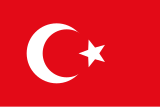Османты импери
Османты, Османы кæнæ Оттоманты импери (осмайнаг туркаг æвзагыл دولتْ علیّه عثمانیّه Devlet-i Âliye-yi Osmâniyye, нырыккон туркаг æвзагыл: Osmanlı İmparatorluğu) уыд осмайнаг султанты (хуындæджерты) паддзахад 1299-æм азæй 1923-æм азы онг. Йæ тæмæны (XVI-XVII æнусты) империйы сконды уыдысты Анатоли, Хæстæг Скæсæн, Цæгат Африкæ, Балканы æрдæгсакъадах æмæ ма цалдæр æндæр регионы.
Империйы сæйраг сахар уыд Константинополь, фæстæдæр зындгонд куыд Стамбул.
Истори
ивынФыццаг Дунеон хæсты фæстæ импери фехæлди. Йæ раздæр зæххытæ байстой Франц æмæ Стыр Британи.
1923-æм азы 29 октябры расидтæуыд Турчы Республикæ, йæ фыццаг президент сси хæстон хъæбатыр Мустафа Кемаль, фæстæдæр йæ мыггагæн Ататюрк (туркæгты фыд) чи райста, уый. Йæ фынддæс азыйы президентады дæргъы Ататюрчы къухы бафтыд осмайнаг паддзахады хæлддзæгты ног туркаг паддзахад рацаразын, ныры онг дæр уымæн стыр цыт кæнынц Турчы.
Литературæ
ивын- Еремеев Д. Е., Мейер М. С. История Турции в средние века и новое время. М.: Изд-во МГУ, 1992.
- Петросян Ю. А., Османская империя. М., 1990.
Фиппаинæгтæ
ивын- ↑
- Learning to Read in the Late Ottoman Empire and the Early Turkish Republic, B. Fortna, page 50;"Although in the late Ottoman period Persian was taught in the state schools...."
- Persian Historiography and Geography, Bertold Spuler, page 68, "On the whole, the circumstance in Turkey took a similar course: in Anatolia, the Persian language had played a significant role as the carrier of civilization.[..]..where it was at time, to some extent, the language of diplomacy...However Persian maintained its position also during the early Ottoman period in the composition of histories and even Sultan Salim I, a bitter enemy of Iran and the Shi'ites, wrote poetry in Persian. Besides some poetical adaptations, the most important historiographical works are: Idris Bidlisi's flowery "Hasht Bihist", or Seven Paradises, begun in 1502 by the request of Sultan Bayazid II and covering the first eight Ottoman rulers.."
- Picturing History at the Ottoman Court, Emine Fetvacı, page 31, "Persian literature, and belles-lettres in particular, were part of the curriculum: a Persian dictionary, a manual on prose composition; and Sa'dis "Gulistan", on of the classics of Persian poetry, were borrowed. All these title would be appropriate in the religious and cultural eudcation of the newly converted young men.
- Persian Historiography: History of Persian Literature A, Volume 10, edited by Ehsan Yarshater, Charles Melville, page 437;"...Persian held a privileged place in Ottoman letters. Persian historical literature was first patronized during the reign of Mehmed II and continued unabated until the end of the 16th century.
- ↑ Flynn, Thomas O. The Western Christian Presence in the Russias and Qājār Persia, c.1760–c.1870(англ.). — BRILL, 2017. — ISBN 9789004313545.
- ↑ Turchin, Peter; Adams, Jonathan M.; Hall, Thomas D. East-West Orientation of Historical Empires(æбæлв.) // Journal of world-systems research. — 2006. — December (т. 12, № 2). — С. 223. — ISSN 1076-156X. Архивировано 20 майы 2019 года.
- ↑ Rein Taagepera. Expansion and Contraction Patterns of Large Polities: Context for Russia(англ.) // International Studies Quarterly : journal. — 1997. — September (vol. 41, no. 3). — P. 498. — ISSN 0020-8833. — doi:10.1111/0020-8833.00053. — .
- ↑ Kinross, 1979, p. 281.
- ↑ David Nicolle, John F. Haldon, Stephen R. Turnbull. The fall of Constantinople: the Ottoman conquest of Byzantium. — Oxford ; New York: Osprey, 2007. — 256 с. — ISBN 978-1-84603-200-4.
- ↑ Али-заде А. А. Халифат // Исламский энциклопедический словарь. — М. : Ансар, 2007. — С. 841. — ISBN 978-5-98443-025-8. (CC BY-SA 3.0)


